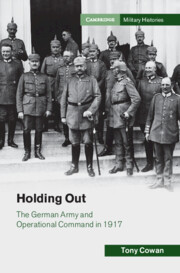Book contents
- Holding Out
- Cambridge Military Histories
- Holding Out
- Copyright page
- Dedication
- Contents
- Figures
- Maps
- Tables
- Acknowledgements
- Comparative Ranks
- Chronology
- Abbreviations
- General key to maps
- Introduction
- 1 Context
- 2 Principles
- 3 Organisation
- 4 Personality
- 5 Intelligence
- 6 Communication
- 7 Learning
- 8 Performance
- Conclusion
- Bibliography
- Index
- Holding Out
- Cambridge Military Histories
- Holding Out
- Copyright page
- Dedication
- Contents
- Figures
- Maps
- Tables
- Acknowledgements
- Comparative Ranks
- Chronology
- Abbreviations
- General key to maps
- Introduction
- 1 Context
- 2 Principles
- 3 Organisation
- 4 Personality
- 5 Intelligence
- 6 Communication
- 7 Learning
- 8 Performance
- Conclusion
- Bibliography
- Index
Summary
Final command task: winning, by preventing a breakthrough and inflicting maximum casualties while preserving German forces. German view of combat value (fighting power); assessment of divisions’ intrinsic (long-term) and current (short-term) combat value. Nearly half the army was unfit for major combat.
The army fulfilled both parts of this command task in spring 1917, but suffered as much damage as during the Somme over the same period, and more than at Verdun or Third Ypres. The system for assessing current combat value helped overcome this potential crisis. Nevertheless, reserves were running out, field strength fell and the army displayed increasing distress.
Section on why the offensive failed from the Entente side: shortcomings in grand strategy, strategy, operations and tactics. But it was not doomed to failure: counterfactual on how it could have gone better. German commanders took it very seriously, rightly as the great damage suffered by the army shows.
Keywords
- Type
- Chapter
- Information
- Holding OutThe German Army and Operational Command in 1917, pp. 245 - 275Publisher: Cambridge University PressPrint publication year: 2023

